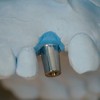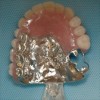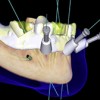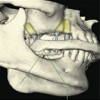Removable partial dentures (RPD) will continue to be one of the primary methods used to restore missing dentition for the foreseeable future. Treatment of the partially edentulous patient has become increasingly sophisticated in recent decades and when this treatment is planned and executed properly existing dentition and associated structures will be preserved and the treatment will last the life of the compliant patient. This program reviews some of the basic principles of RPDs and outlines the reasons why patients often select RPD treatment as opposed implant therapy when cost factors and anatomic limitations and other factors are taken into consideration.
Removable Partial Dentures – Introduction and Basic Components of RPD’s — Course Transcript
- 1. Introduction and Basic Principles Ting Ling Chang and John Beumer III Division of Advanced Prosthodontics UCLA School of DentistryThis program of instruction is protected by copyright ©. No portion ofthis program of instruction may be reproduced, recorded or transferredby any means electronic, digital, photographic, mechanical etc., or byany information storage or retrieval system, without prior permission.
- 2. The Partially Edentulous PatientA turning point in the life of the dentitionv Multiple missing teethv Teeth may move out of arch symmetry because of loss of adjacent teeth or space irregularities Courtesy Dr. A Davodi Courtesy Dr. T. Berg
- 3. The Partially Edentulous Patient A turning point in the life of the dentitionv When teeth lack mesial or distal contacts the arch is unable to function as a unitv Loss of this arch integrity is the first step in a cycle that leads to arch disorganization and, continued loss of teeth and eventually edentulism Courtesy Dr. A. Davodi Courtesy Dr. T. Berg
- 4. The Ucla philosphy of RPD design (The RPI system per Professor FJ Kratochvil)1st priority v The prosthesis must be designed and function in a way to preserve the health and integrity of the remaining dentition and edentulous soft tissue bearing surfaces. v The principle focus of the design philosophy is on extension based removable partial dentures v If these cases are improperly designed, the prosthesis will damage the remaining teeth and soft tissues. Courtesy Dr. A. Davodi Courtesy Dr. T. Berg
- 5. A typical partially edentulous patientv Missing posterior occlusionv Moderate wear and reduced vertical dimension of occlusionv Numerous spaces between the teethv Unfavorable tooth contours for RPD support and retention Courtesy Dr. A. Davodi Courtesy Dr. A. Davodi
- 6. The Partially Edentulous PatientNatural progression of a dental arch in this condition v Loss of stability of individual teeth v Movement and tipping of teeth v Altered occlusal relationships and the plane of occlusion v Loss of vertical dimension v Unfavorable leverage forces on the individual teeth leading to further compromise of the periodontium Courtesy Dr. A. Davodi Courtesy Dr. A. Davodi
- 7. The Partially Edentulous PatientNatural progression of a dental arch in this condition v Loss of stability of individual teeth v Movement and tipping of teeth v Altered occlusal relationships and the plane of occlusion v Loss of vertical dimension v Unfavorable leverage forces on the individual teeth leading to further compromise of the periodontium Courtesy Dr. T. Berg
- 8. A typical partially edentulous patient – Goals v Replace missing posterior occlusion v Improve esthetics and function v Restore arch integrity v Provide proper stability (bracing), support and retention for the RPD Courtesy Dr. A. Davodi Courtesy Dr. A. Davodi
- 9. A typical partially edentulous patientv Replace missing posterior occlusionv Improve esthetics and functionv Provide proper stability (bracing), support and retention for the RPD The prosthesis must be designed and function in a way to preserve the health and integrity of the remaining dentition and edentulous soft tissue bearing surfaces. Courtesy Dr. A. Davodi Courtesy Dr. A. Davodi
- 10. Objectives of treatment of the partially edentulousv Reorganize, stabilize and restore the integrity of the dental arches. v Restore tooth to tooth contacts (mesial-distal) v Restore the plane of occlusion v Restore the vertical dimension of occlusion v Restore a biomechanically harmonious occlusion Courtesy Dr. A. Davodi Courtesy Dr. A. Davodi
- 11. Objectives of treatment of the partially edentulousReorganize, stabilize and restore the integrity of thedental arches. Methods to accomplish these objectives: v Orthodontic therapy to reposition teeth v Preprosthetic surgery v Periodontal therapy v Conventional restorative procedures and fixed partial dentures v Removable partial dentures Courtesy Dr. A. Davodi Courtesy Dr. A. Davodi
- 12. Methods to accomplish these objectives: v Orthodontic therapy to reposition teeth and upright partial denture abutments v Pre prosthetic surgery Courtesy Dr. T. Berg
- 13. Methods to accomplish these objectives: v Pre prosthetic surgery vOrthognathic surgery to reposition posterior maxillary segment superiorly Courtesy Dr. T. Berg
- 14. Methods to accomplish these objectives: v Pre prosthetic surgery vRemoval of unwanted tori Courtesy Dr. T. Berg Courtesy Dr. T. Berg
- 15. Methods to accomplish these objectives: Periodontal therapyAbutments adjacent to extension bases with compromisedperiodontal support may require special consideration: v Splinting of abutments when crown root ratios become unfavorable v Stabilization of multiple abutments with RPD framework v Attention to occlusion: Anterior guidance with centric only contact in the extension base region. Courtesy Dr. T. Berg Courtesy Dr. T. Berg
- 16. Methods to therapyPeriodontal accomplish these objectives:Abutments adjacent to extension bases with compromisedperiodontal support may require special consideration:v Splinting of abutments when crown root ratios become unfavorablev Stabilization of multiple abutments with RPD frameworkv Attention to occlusion: Anterior guidance with centric only contact in the extension base region.
- 17. Methods to accomplish these objectives: Periodontal therapy Abutments adjacent to extension bases with compromised periodontal support may require special consideration: v Splinting of abutments when crown root ratios become unfavorable v Stabilization of multiple abutments with RPD framework v Attention to occlusion: Anterior guidance with centric only contact in the extension base region. Courtesy Dr. E. King Courtesy Dr. E. King
- 18. Methods to therapy Periodontal accomplish these objectives:Abutments adjacent to extension bases with compromisedperiodontal support may require special consideration v Widening the zone of attached gingiva Courtesy Dr. T. Berg Courtesy Dr. T. Berg
- 19. Methods to accomplish these objectives:Fixed partial dentures and individual restorations v Diastemas have been closed v Missing space filled v Arch integrity has been restored Courtesy Dr. A. Davodi Courtesy Dr. A. Davodi Courtesy Dr. A. Davodi
- 20. Methods to accomplish these objectivesArch integrity has been restored v In this case with a proximal plate between the cuspid and premolar (arrow) Courtesy Dr. T. Berg
- 21. Methods to accomplish these objectivesArch integrity has been restored with the rests and proximal plates of the RPD framework in a periodontally impaired residual dentition Courtesy Dr. T. Berg Courtesy Dr. T. Berg
- 22. Methods to accomplish these objectives What is the role of endodontics??v Endodonticallytreated teeth with compromised periodontal support adjacent to extension bases may be poor candidates for RPD abutments v Higher susceptibility to fracture v Higher stress levels within the root v Avoid occlusal rests on these teeth if possible
- 23. Methods to accomplish these objectives What is the role of endodontics??Endodontically treated teeth withcompromised periodontal supportadjacent to extension bases maybe poor candidates for RPDabutments v Higher susceptibility to fracture v Higher stress levels within the root v Avoid occlusal rests on these teeth if possible Courtesy Dr. T. Berg Tooth # 12 was treated endodontically. Note the absence of a rest (arrow).
- 24. Methods to accomplish these objectives What is the role of endodontics??v To resolve occlusal plane problemsv To retain teethv To retain teeth as overdenture abutments Courtesy Dr. T. Berg
- 25. Methods to accomplish these objectives What is the role of endodontics?? v Retain teeth as overdenture abutments
- 26. Methods to accomplish these objectivesv Individual restorationsv Recontouring the occlusal surface
- 27. Methods to accomplish these objectivesv Individual restorations
- 28. Current Concepts of Removable Partial Denture Designv Whyis it so important to be familiar with the basic principles required to fabricate removable partial denturesv Because this will be the primary method used to restore missing dentition and arch integrity for the foreseeable future
- 29. The Future of RPD’s is Bright!v Aging populationv Fixed is not possible in many partially edentulous patientsv Osseointegrated implants are costly and as a result this service will be available to very few individualsv Very significant need
- 30. RPD Indicationsv Long edentulous spansv Structurally and anatomically compromised abutments vAbsence of adequate periodontal supportv Need for cross-arch stabilization
- 31. RPD Indicationsv Long edentulous spansv Structurally and anatomically compromised abutments v Absence of adequate periodontal supportv Need for cross-arch stabilization
- 32. RPD Indicationsv Distal or anterior extensionv Need to restore soft and hard tissue contoursv Anterior esthetics
- 33. RPD Indicationsv Age and healthv Attitude and desires of pt. vCost of implants and fixedv Ease of plaque removal
- 34. Removable Partial DenturesvTooth loss is creating more partially edentulous patientsvIn many patients fixed partial dentures are not indicatedvCost of implants precludes this therapy for most patientsvTooth loss patterns – A significant number of patients need extension base RPD’s Most commonly retained teeth #22-27
- 35. (Bassi et al, 1996) What about implants? RPD’s will be needed in the future l Numbers of patients continues to expand l Unmet needs continue to increase Implants will not replace RPD’s l 40 patients considered implant fixed partial dentures l Barriers to receiving implants l Economic concerns l Poor patient compliance l Patient satisfied with the RPD l Fearful or skeptical of the result l One patient received implants out of the 40 originally screenedProbably less than 3% of all partially edentulous patientsin the United States will be restored with implant therapy
- 36. RPD’s and compromise of the remaining dentitionRPD’s and oral health v Perceived compromise of the remaining teeth by the RPD is not supported by the evidence v No evidence of destruction of the periodontium of remaining teeth v Most important factors are patient compliance and close followup
- 37. RPD’s and compromise of the remaining dentitionCausation or association v Some have maintained that the presence of an RPD accelerates existing dental disease v However, the risk is reduced with appropriate followup and oral compliance v Poor outcomes in some studies may be related to the fact this patient group may have low dental IQ
- 38. Patient Satisfaction – RPD’s Patient satisfaction l Review of 400 mandibular RPD’s provided by private dentists Results (Frank et al, 1998) l 74% satisfied with their RPD’s l 26% dissatisfied with their RPD’sThis a remarkable finding particularly when you consider that most RPD’s are improperly designed and fabricated.
- 39. RPD Quality ControlDesign standards v Less than 5% of casts submitted to dental labs have designs v Less than 5% of casts submitted to dental labs have definable rests v In many studies significant numbers of RPD’s do not meet even half of the usual customary design standards v In one recent study, only 1/3 of the RPD’s were judged to be adequate
- 40. Prosthodontic Educationv Most dentists are poorly trained in RPD designv In some dental schools as many as a quarter of graduates have never made either a RPD, a complete denture or a fixed bridgev Only 14% of US dental schools offer clinical experience in restoring dental implants* *ADEA Implant Workshop Survery, 2004
- 41. Why consider RPD’sClinical trials – Fixed vs Removable l 5 year followup l Removable vs fixed outcomes in Class I and Class II patients l RPD’s vs tooth and implant supported FPD’sResults l No periodontal differences at 5 years l Maintenance needs for RPD’s is greater Kapur et al, 1989 Budtz-Jorgenson et al, 1990
- 42. RPD’s vs Implants Mastication efficiencyA randomized clinical trial comparing Fixedimplant-supported and removable partial dentures Kapur et, al,1993
- 43. l Both RPD and FPD treatments were successful in approximately 80% of the patients over 5 years.l Both treatments were equally effective in improving chewing function.l A large number of patients in both groups expressed satisfaction with the prosthesis. Improvement with FPD was more frequent than with RPD for several perceptions.l Despite the slight superiority of the FPD in terms of patient satisfaction, lack of functional differences and success rates do not support the selection of implant-supported FPD over RPD, without consideration of other factors.
- 44. Limiting factors for placement of implants Posterior maxilla and mandiblel Pneumatized sinusl Presence of inferior alveolar nerve
- 45. Sinus Lift and Graft This procedure has shown good predictability
- 46. Sinus Lift and Graft This patient was restored following a sinus lift and graft. Autogenous chin bone was used. She is 10 years post treatment and doing well. Success rates over 85% at 5 year followup Problem: vCost $3-5000 per sinus in the US
- 47. Distraction Osteogenesis This procedure has been used successfully. Its usefulness in the posterior maxilla is probably limited. Even if successful onlay grafts to widen the site are almost always necessary 25% relapse rate
- 48. *Removable Partial Dentures*Removable partial dentures provide the patient withmasticatory function equivalent to that obtained with animplant supported fixed partial denture and this serviceshould be offered to the patient before grafting isconsidered.
- 49. Posterior Mandible – Limiting Factors v Inferior alveolar nerve (arrow) v Insufficient bone over the nerve to permit placement of an implant of suitable length
- 50. Posterior Mandible – Limiting Factors Many patients such as this one, present with moderate to severe resorption precluding placement of implants unless the inferior alveolar nerve displaced.
- 51. Displacement of the Inferior Alveolar Nerve This procedure enables placement of implants of sufficient length with bicortical anchorage. The morbidities associated with injury may be severe. Therefore, these issues must be thoroughly discussed with the patient before proceeding with the procedure.
- 52. Bone AugmentationAugmentation of vertical defects in posterior quadrantswith free autogenous bone grafts has beenunpredictable. vAverage gain is only about 2-3 mm. vSuch grafts are subject to resorption particularly upon occlusal loading (relapse rate is 75%). v Initial anchorage may be more difficult to achieve A B
- 53. Use of Short Wide Diameter Implants in the Posterior MandibleLength is more important than width. Short wide diameter implantsappear to be susceptible to overload when used in linear configurationssuch as shown here. 2 years 5 years
- 54. *Removable Partial Dentures*Removable partial dentures provide the patient withmasticatory function equivalent to that obtained with animplant supported fixed partial dentures and thisshould treatment be offered to the patient beforegrafting is considered.
- 55. The Basic Principles of Removable Prosthodontics v Support v Stability (bracing) v RetentionOur goal is to provide these phenomenon for our removablepartial dentures within the physiologic limits of the remainingdentition and edentulous mucosal bearing surfaces.
- 56. Principles of RPD designv Occlusal rests must direct occlusal forces along the long axis of the teeth.v Extension base RPD designs must anticipate and accommodate the movements of the prosthesis during function, without exerting pathologic stresses on the abutment teethv Major connectors must be rigid.v Guide planes are employed to enhance stability and bracing.v Retention must be within the limits of physiologic tolerance of the periodontal ligament.v Maximum support is gained from the adjacent soft tissue denture bearing surfaces.v Designs must consider the needs of cleansibility.
- 57. Components of a Removable Partial Denturesv Positive Restsv Direct retainersv Major connectorv Minor connector v Proximal platev Denture base connectorv Denture basev Teeth
- 58. Components of a Removable Partial Denturesv Restsv Directretainersv Major connectorv Minor connectorv Proximal platev Denture base connector A rigid extension of a partial denture whichv Denture base contacts a remainingv Teeth tooth in a prepared rest seat to transmit vertical or horizontal forces.
- 59. Components of a Removable Partial Denturesv Restsv Directretainersv Major connectorv Minor connectorv Proximal platev Denture base connector Function: vProvide support and onv Denture base occasion stability (bracing) vControls the position ofv Teeth the prosthesis in relation to the teeth and soft tissue supporting structures
- 60. Components of a Removable Partial Denturesv Restsv Directretainersv Major connectorv Minor connectorv Proximal platev Denture base connector That component of av Denture base removable partial denture used to preventv Teeth dislodgement, consisting of a clasp assembly or precision attachment
- 61. Components of a Removable Partial Denturesv Restv Directretainersv Major connectorv Minor connectorv Proximal plate Function:v Denture base connector vProvide retention and stability (bracing)v Denture base vControl the position of the prosthesis in relation to thev Teeth remaining teeth and supporting structures
- 62. Components of a Removable v Rest v Directretainers v Major connector v Minor connector v Proximal plate v Denture base connector That part of a removable v Denture base partial denture that joins v Teeth the components on one side of the arch to those on the opposite side.
- 63. Components of a Removable v Rest v Directretainers v Major connector v Minor connector v Proximal plate v Denture base connector Function: vProvide support v Denture base vUnite and stabilize the v Teeth remaining teeth in the arch
- 64. Components of a Removable Partial Dentures v Rest v Direct retainers v Major connector v Minor connector v Proximal plate v Denture base connector The connecting link between the major connector or base of the v Denture base removable partial denture and the other units of the prosthesis, v Teeth such as the clasp assembly, indirect retainers, occlusal rests, or cingulum rests
- 65. Components of a Removable Partial Denturesv Restv Direct retainersv Major connectorv Minor connectorv Proximal platev Denture base connector Function:v Denture base vProvide stability (bracing)v Teeth
- 66. Components of a Removable Partial Denturesv Restv Directretainersv Major connectorv Minor connector v Proximal platev Denture base connectorv Denture base A plate of metal inv Teeth contact with the proximal surface of an abutment tooth
- 67. Components of a Removable Partial Denturesv Restv Directretainersv Major connectorv Minor connectorv Rest v Proximal platev Denture base connector Function:v Denture base vProvide stability byv Teeth anterior posterior bracing action vRetention
- 68. Components of a Removable Partial Denturesv Restv Directretainersv Major connectorv Minor connectorv Restv Proximal platev Denture base connector That part of thev Denture base framework to whichv Teeth the resin denture base is connected
- 69. Components of a Removable Partial Denturesv Restv Directretainersv Major connectorv Minor connectorv Restv Proximal platev Denture base connector Function:v Denture base Retain denturev Teeth base
- 70. Components of a Removable Partial Denturesv Restv Directretainersv Major connectorv Minor connectorv Restv Proximal platev Denture base connectorv Denture base That part of denture that rests onv Teeth the foundation tissues and to which the teeth are attached
- 71. Components of a Removable Partial Denturesv Restv Directretainersv Major connectorv Minor connectorv Restv Proximal platev Denture base connectorv Denture basev Teeth
- 72. v Visit ffofr.org for hundreds of additional lectures on Complete Dentures, Implant Dentistry, Removable Partial Dentures, Esthetic Dentistry and Maxillofacial Prosthetics.v The lectures are free.v Our objective is to create the best and most comprehensive online programs of instruction in Prosthodontics


 Cement Retention vs Screw Retention
Cement Retention vs Screw Retention
 Implants and RPDs
Implants and RPDs
 Computer Guided Treatment Planning and Surgery
Computer Guided Treatment Planning and Surgery
 Angled Implants
Angled Implants
